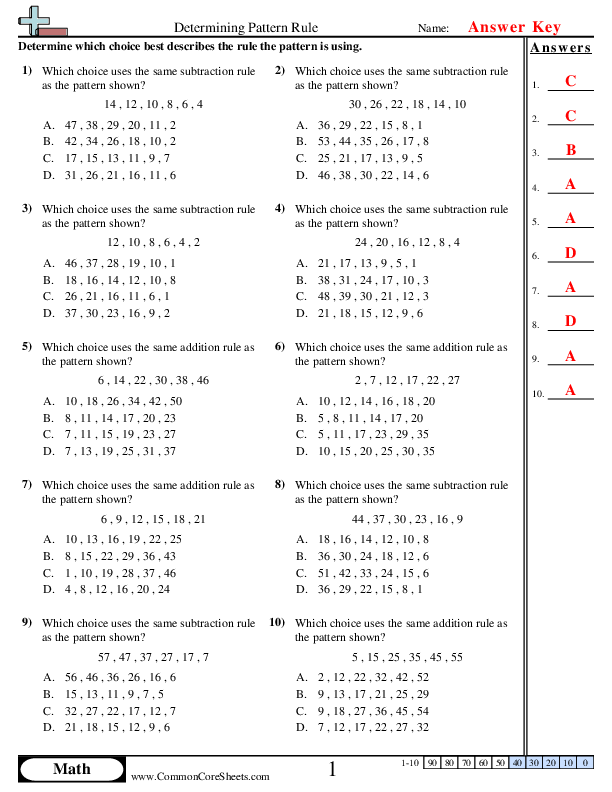Our patterns and function machines worksheets are the best on the internet for helping students understand these important math concepts. These worksheets are free to download and print, making them a convenient and budget-friendly resource for teachers and homeschooling parents. Our patterns and function machines worksheets cover a wide range of skills, including identifying and extending patterns, evaluating function machines, and solving word problems involving patterns and functions. With our patterns and function machines worksheets, students will have the opportunity to practice and apply their skills in a variety of contexts, reinforcing their understanding of these concepts.
Browse Sheets By Problem Type
×
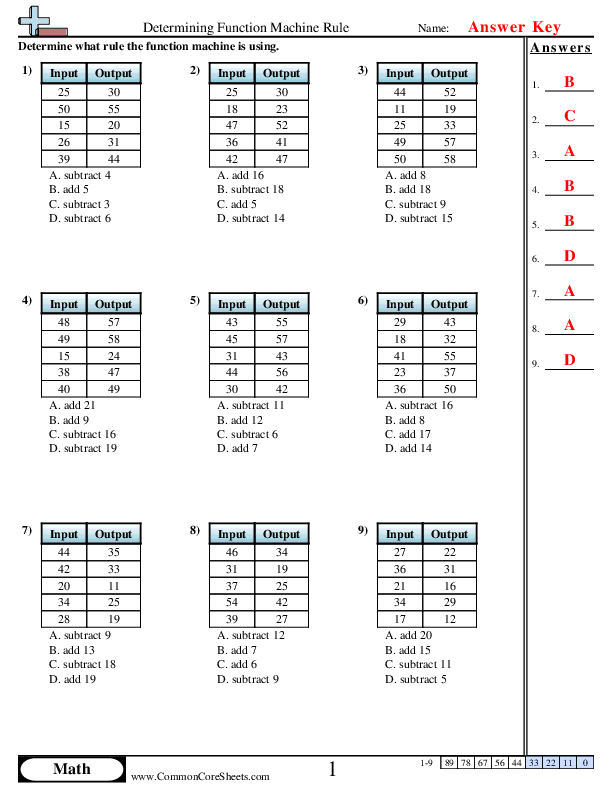
Determining Function Machine Rule (+ or -) (MC)
3oa9


×
Description:
"This worksheet is designed to enhance children's understanding of mathematical functions and rules. It contains nine engaging problems that require pupils to determine the function machine rule, hence developing their mathematical reasoning skills. The worksheet is highly versatile; it can be customized to suit individual learning needs, transformed into flash cards for a more tangible learning experience, or used effectively in distance learning scenarios."

×
Student Goals:
Problem-solving SkillsKids will enhance their problem-solving skills as they must decode the patterns of numerous function machine problems effectively. By doing so, they become proficient in understanding complex patterns, promoting logical thinking and ingenuity.Mathematical KnowledgeThis worksheet provides the learners broad knowledge about mathematical operations such as addition, subtraction, and the concept of input and output in mathematics. By working through these problems, learners reinforce their understanding of fundamental math principles and theories.Critical ThinkingThe learners' ability to think critically is significantly bolstered after the completion of the worksheet. The Function Machine Rules worksheet hones their skills of deduction and requires them to apply their pre-existing knowledge of mathematical operations to establish a connection between input and output numbers.Subject MasteryAfter concluding this educative exercise, students should have gained proficiency in the subject of math, allowing them to comfortably manage math problems that revolve around the idea of function machines. The worksheet helps in building confidence and understanding, supporting them to perform higher in this subject.Concentration ImprovementThis worksheet assists learners in enhancing their focus and concentration skills. By the end of it, students should be able to improve their attention to detail. It aids them in paying closer attention to patterns and numbers, increasing not only their math skills but also their overall concentration abilities.Bettered Academic PerformanceCompleting such worksheets frequently enables pupils to elevate their academic performance. This worksheet especially enables an overall better understanding of complex mathematical theories and operations which is vital for student's academic growth, also enriching their knowledge base.Independent LearningThis exercise supports pupils in becoming independent learners. As they navigate their way through understanding the rules of the function machine, they inadvertently learn to rely on their skills and knowledge. This gives them the confidence to tackle more complex mathematical problems on their own in the future.


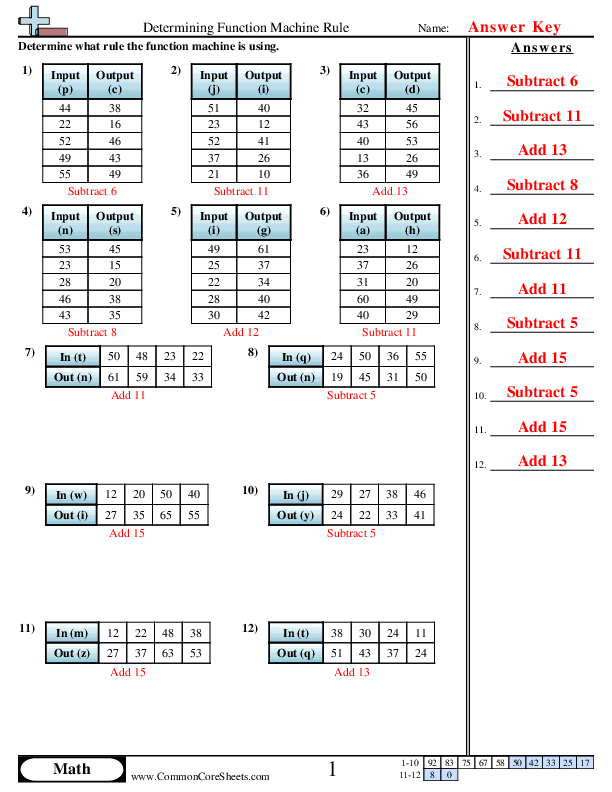
Determining Function Machine Rule (+ or -)
3oa9


×
Description:
This worksheet is designed to enhance children's understanding of mathematical functions, specifically addition and subtraction rules. It provides a "Function Machine Rule" in which kids decipher the rule by observing input-output patterns. With 12 customizable problems, this educational resource can be re-purposed into flashcards or used in a distance learning setting, making math learning fun, interactive, and flexible for young learners.

×
Student Goals:
Understanding of basic function machinesStudents will have a clear and practical understanding of basic function machines, learning how to input values and calculate the output using the specific function rule provided such as addition or subtraction.Applying basic arithmetic operationsIn the process of identifying function rules, students would have applied basic arithmetic operations, namely addition and subtraction, thus sharpening their skills in these fundamental areas of math.Problem-solving and critical thinking skillsThis worksheet challenges students to figure out the rule in the function machines. This infers a development in their problem-solving capacities and critical thinking skills, as they observe patterns, infer rules and apply the acquired knowledge to new problems.Mathematical fluencySince the worksheet demands them to process multiple numbers and perform calculations, students would achieve higher fluency and efficiency in their arithmetic abilities pertaining to addition and subtraction. This constant feature throughout the worksheet enables students to improve speed, accuracy, and comprehension in the fundamental arithmetic operations.Understanding of mathematical functionsStudents will be able to achieve a practical knowledge of mathematical functions. They will learn the import of an independent variable (input) and how it gives rise to a dependent variable (output), fostering their understanding of interdependence in function machine problems.Preparation for advanced algebraThis worksheet serves as an ideal preliminary exposure to algebraic concepts. The knowledge and skills acquired will facilitate their learning of more advanced algebraic concepts later, such as symbolic expressions, equations, and function graphs.


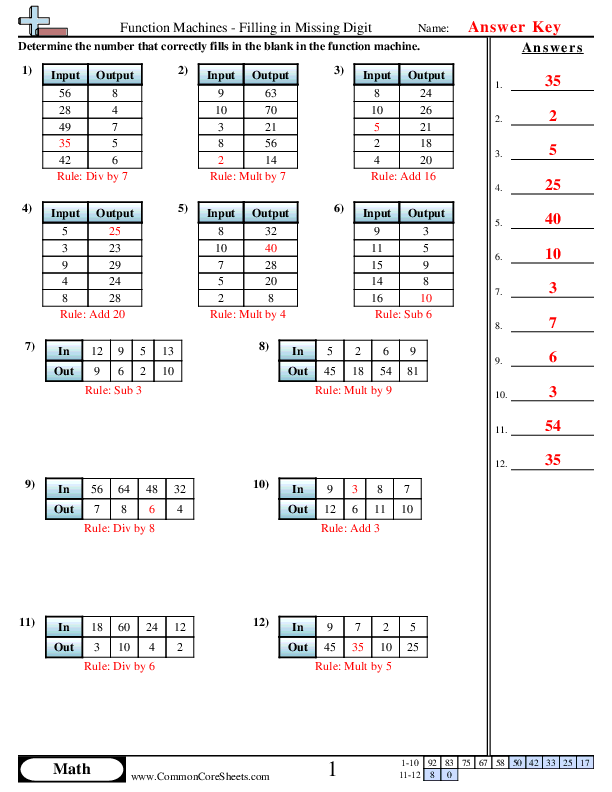
Add/Sub/Mult/Div
6rp3a


×
Description:
"This worksheet is designed to help children understand the concept of function machines in math by filling in the missing digit. With 12 interactive problems that involve subtraction, addition, multiplication, and division rules, it offers a dynamic way to foster computational skills. The customizable nature allows its use as flash cards or for distance learning, suiting individual learning styles and needs."

×
Student Goals:
Mastery in Basic Math OperationsChildren who complete this worksheet should display fluency in the four fundamental arithmetic operations, namely, addition, subtraction, multiplication, and division. They should be able to perform these operations without difficulty and apply them correctly in different scenarios, demonstrating foundational math knowledge and familiarity with number operations.Enhanced Problem-Solving SkillThe worksheet aims to push the students to utilize problems to challenge their thinking and foster their problem-solving abilities. After completing the sheet, students should be adept at solving mathematical problems and in identifying patterns. Their analytical thinking and logical reasoning abilities should be improved, equipping them with the necessary skills to tackle more complex math problems in the future.Understanding of Function Machines ConceptCompletion of the said worksheet should ensure the students' understanding of the Function Machines concept. They should be capable to recognize and apply the concept in a practical setting, grasp how the input and output correlates, and accurately identify the rule used in each function machine.Critical Thinking DevelopmentThe worksheet focuses on problem-solving exercises that encourage critical thinking. After completion, students should be adept at using judgment to decipher patterns in numbers, make mathematical predictions, and draw valid inferences. These tasks are aimed at improving their ability to think independently and flexibly, critical skills that will be beneficial for later academic and life challenges.Accuracy and Speed in ComputationThe worksheet provides ample practice to improve the accuracy and speed of computation. Students who complete the worksheet should be able to perform mathematical computation without errors, enhancing their computational accuracy. The repeated practice should also help increase their computational speed.


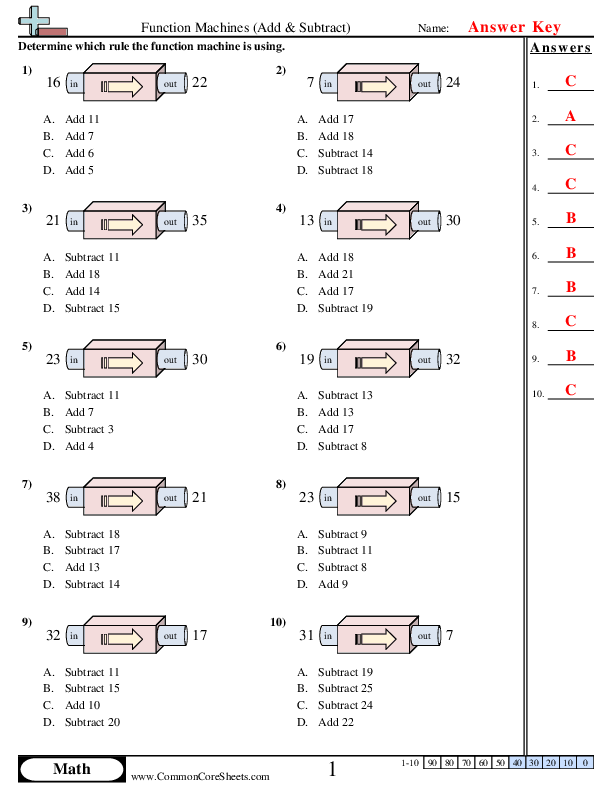
Adding & Subtracting below 50 (Multiple Choice)


×
Description:
"This worksheet is designed to enhance children's mathematical skills by exploring functions through addition and subtraction. It features ten problems, challenging students to understand the 'in & out' pattern of function machines, aiding their comprehension of basic algebraic concepts. Versatile and customizable, this resource can be adapted to flash cards or used in distance learning settings, making it a beneficial component of various educational platforms."

×
Student Goals:
Understanding Basic Mathematical OperationsUpon the completion of this worksheet, students should have a reinforced understanding of addition and subtraction, fundamental operations in arithmetic. They will be able to accurately add and subtract numbers, thus enhancing their mathematical knowledge and paving the way for more complex calculations in the future.Improvement in Problem-solving SkillsThe function machine approach encourages independent thinking, enhancing students' problem-solving skills. They should feel comfortable working through problems systematically, learning to apply the appropriate operation (whether addition or subtraction) based on given input and output of the function machine. These skills can be readily applied to tackle more challenging mathematical experiences.Ability to Interpret Mathematical InstructionsFrom this worksheet, students should further develop their capacity to interpret mathematical instructions. As each problem requires them to apply either an add or subtract command to find the corresponding in or out number, they will need to carefully read and understand each instruction.Critical Thinking and Logical ReasoningSkills in critical thinking and logical reasoning should be nurtured through the completion of this worksheet. By working out which operation to apply for each problem or how to arrive at the answer, students fine-tune their thinking ability, develop their reasoning capacity, and strengthen their logical understanding.Sharpen Numeric AcuityThe completion of this worksheet helps sharpen students' numeric acuity. Through continuous practice of addition and subtraction problems, students will become faster and more accurate in their computations. This will be beneficial not only for their math education but also for developing computational skills necessary in everyday life.Confidence in Math AbilityLastly, successfully working through this worksheet should foster students' confidence in their math abilities. Each correct answer reinforces their understanding of mathematical concepts, providing them the self-confidence to attempt more complex problems. This confidence is an important factor in encouraging a lifelong interest and success in mathematics.


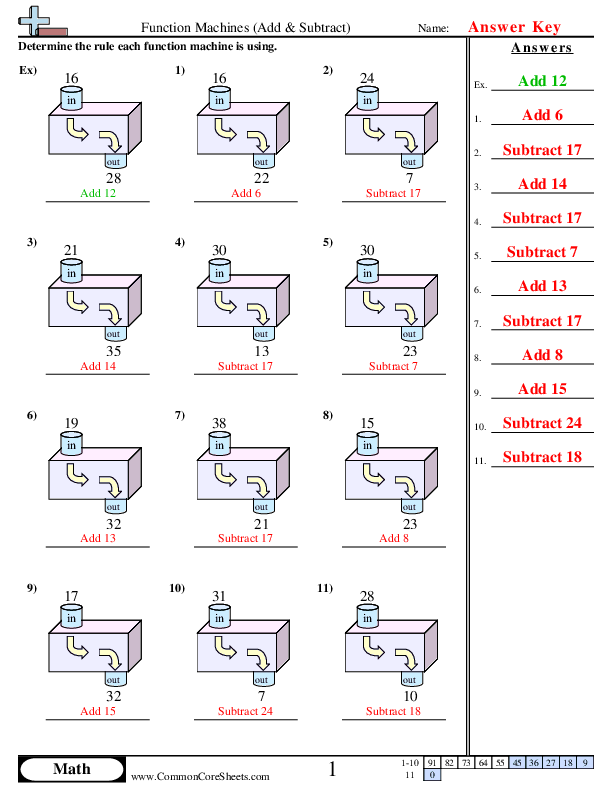
Adding & Subtracting below 50


×
Description:
"This worksheet is designed to improve children's elementary math skills by using a 'Function Machines' concept focused on adding and subtracting. It features 11 customizable problems that encourage subtraction and addition operations, thus enhancing kids’ mental arithmetic abilities. The adjustable nature of this resource makes it applicable for distance learning, convenient for transforming into flashcards, and adaptable to different learning needs and paces."

×
Student Goals:
Mathematical Operations MasteryUpon completion of this worksheet, students should have a refined understanding and comprehensive command of addition and subtraction. They should be able to seamlessly add and subtract numbers within a wide range, honing their mental arithmetic skills and gaining confidence in basic operations. This will serve as a strong foundation for future mathematical challenges both in the classroom and practical life.Critical Thinking Skills DevelopmentAs they work through the problems provided in this worksheet, students are put in the position to analyze each problem and strategize about which operations apply in different scenarios. This will help develop their critical thinking skills, which are important not only in math but also in many aspects of life. They would be more proficient in applying logical thought to problems and situations.Improving Attention to DetailOne crucial requirement for successful completion of this worksheet is careful attention to detail. By closely reading the 'machine' directions and input numbers for each problem, students learn to avoid hasty errors, thereby raising their accuracy in problem-solving tasks. This diligence will translate to improved care and precision in their further mathematical exercises and other subjects.Enhancing Problem-Solving AbilitiesAfter working through this set of problems, students would have further honed their problem-solving skills. Every problem demands a solution; therefore, they learn to be tenacious, patient, and innovative thinkers. This reinforces their understanding that every problem has a solution, a lifelong skill that goes beyond mathematics.Increasing Speed and EfficiencyRepetitive addition and subtraction exercises in this worksheet allow the students to increase their speed and efficiency in performing these operations. They get a chance to experiment with different methods and select the one which suits them best, optimizing their mathematical abilities. It boosts their confidence and performance in timed exams and situations where rapid calculation skills are required.Real Life Application SkillsFinally, the success in completion of this worksheet assures that students have developed a good sense of number manipulation, which is a very basic life skill. Whether they are managing money, baking, or measuring things, addition and subtraction are essential operations. By understanding these mathematical processes, the students are better equipped to handle real-life situations requiring quick, precise calculations.



Adding & Subtracting below 50


×
Description:
"This worksheet is designed to improve children's elementary math skills by using a 'Function Machines' concept focused on adding and subtracting. It features 11 customizable problems that encourage subtraction and addition operations, thus enhancing kids’ mental arithmetic abilities. The adjustable nature of this resource makes it applicable for distance learning, convenient for transforming into flashcards, and adaptable to different learning needs and paces."

×
Student Goals:
Mathematical Operations MasteryUpon completion of this worksheet, students should have a refined understanding and comprehensive command of addition and subtraction. They should be able to seamlessly add and subtract numbers within a wide range, honing their mental arithmetic skills and gaining confidence in basic operations. This will serve as a strong foundation for future mathematical challenges both in the classroom and practical life.Critical Thinking Skills DevelopmentAs they work through the problems provided in this worksheet, students are put in the position to analyze each problem and strategize about which operations apply in different scenarios. This will help develop their critical thinking skills, which are important not only in math but also in many aspects of life. They would be more proficient in applying logical thought to problems and situations.Improving Attention to DetailOne crucial requirement for successful completion of this worksheet is careful attention to detail. By closely reading the 'machine' directions and input numbers for each problem, students learn to avoid hasty errors, thereby raising their accuracy in problem-solving tasks. This diligence will translate to improved care and precision in their further mathematical exercises and other subjects.Enhancing Problem-Solving AbilitiesAfter working through this set of problems, students would have further honed their problem-solving skills. Every problem demands a solution; therefore, they learn to be tenacious, patient, and innovative thinkers. This reinforces their understanding that every problem has a solution, a lifelong skill that goes beyond mathematics.Increasing Speed and EfficiencyRepetitive addition and subtraction exercises in this worksheet allow the students to increase their speed and efficiency in performing these operations. They get a chance to experiment with different methods and select the one which suits them best, optimizing their mathematical abilities. It boosts their confidence and performance in timed exams and situations where rapid calculation skills are required.Real Life Application SkillsFinally, the success in completion of this worksheet assures that students have developed a good sense of number manipulation, which is a very basic life skill. Whether they are managing money, baking, or measuring things, addition and subtraction are essential operations. By understanding these mathematical processes, the students are better equipped to handle real-life situations requiring quick, precise calculations.


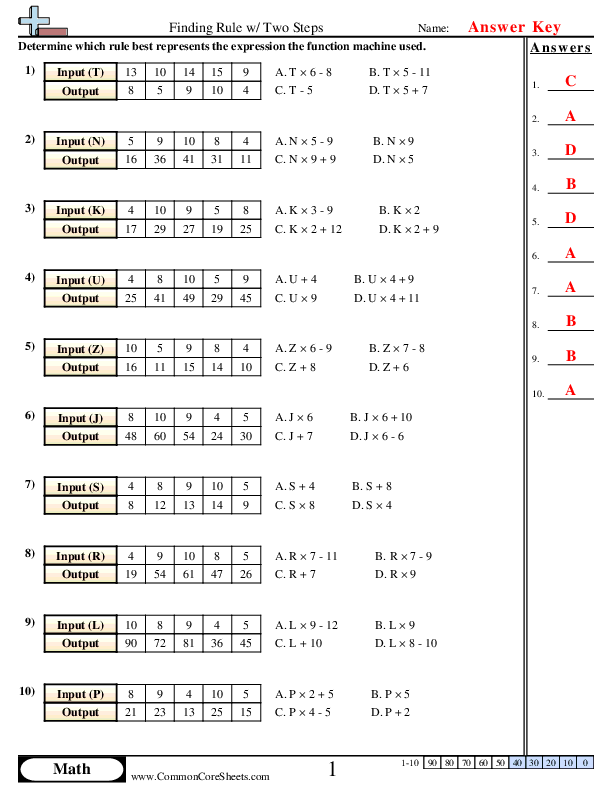
+,-,×,÷ With Variables (2 Steps)


×
Description:
"This worksheet is designed to improve children's math skills by providing 10 problems on finding rules with two steps, using different variables. It challenges learners to perform operations such as multiplication, addition, subtraction, and more. The worksheet's flexibility allows it to be customized, converted into flashcards, or utilized in distance learning environments, making math practice convenient and accessible."

×
Student Goals:
Improved Numerical SkillsAfter successfully completing the worksheet, students will have demonstrated a significant improvement in their numerical skills. This includes fundamental operations such as addition, subtraction, multiplication and division. They will have effectively practiced how these operations can be used in a two-step process to solve more complex math problems.Understanding of Mathematical RulesThis worksheet offers the opportunity for students to explore and understand mathematical rules. By finding solutions to these two-step problems, they have not only applied existing mathematical rules but have also potentially discovered new ones. This fosters a deeper understanding of how numbers and equations work.Logical Thinking and Problem SolvingBy undertaking the problems in the worksheet, students will have honed their logical thinking and problem-solving skills. They must identify the right rule to follow based on their inputs and expected outputs, and this requires critical analysis. These cognitive skills are valuable across all areas of their academic learning journey.Building Confidence in MathCompleting this math worksheet correctly and independently can give students a confidence boost in their mathematical capabilities. Tackling and overcoming challenges in math can reduce anxiety associated with the subject, encouraging a more positive attitude towards math and higher engagement in future mathematical activities.Preparation for Advanced TopicsThe worksheet is an effective primer for more advanced mathematical topics. Mastery of fundamental operations and the ability to undertake two-step problems is critical before students progress onto topics such as algebra and complex equation solving. Successful completion of the worksheet suggests readiness for these more complex topics.Promotion of Continuous LearningLastly, the worksheet promotes continuous learning. Once students complete it, they can go back to analyze the solutions, identify their mistakes, and learn from them. This self-reflection and realization promote a mindset of continuous learning which is beneficial for lifelong education.


Determining Pattern Rules
Link

Identifying Pattern Attributes
4oa5


×
Description:
"This worksheet is designed to hone children's skills in identifying pattern attributes in mathematics. It comprises six engaging problems, asking students to predict sequence outcomes and analyze numeric trends. The content encourages critical thinking and can be personalized to support individual learning pace and style. It offers versatility in usage, easily converted into flashcards or integrated into distance learning programs, fostering an interactive and efficient learning environment."

×
Student Goals:
Understanding Mathematical PatternsAfter completing the worksheet, students should have a solid understanding of mathematical patterns. They should be able to identify the rule of a sequence or pattern based on provided numbers, and predict future numbers in the series. The worksheet reinforces the concept of arithmetic progression, in which there is a common difference between each successive term.Problem Solving SkillsThis worksheet lends itself to the development of problem-solving skills. By attempting to solve the problems on the worksheet, students will learn to apply logic, analytical reasoning, and strategic thought. Persistent tackling of issues fosters the ability to tackle complex problems, making it easier for students to figure out solutions in future mathematical scenarios.Understanding Even and Odd NumbersAdditionally, the exercises included on the worksheet introduce students to the concepts of even and odd numbers. By predicting the nature of future elements in a sequence, students will have a practical understanding of numerical attributes and be able to discern the odd and even characteristics of numerical elements.Enhancing Multiplication SkillsThe worksheet helps students enhance their multiplication skills. Several question prompts require students to perform multiplication operations. This practice will not only reinforce their multiplication capabilities but also will allow them to identify multiplication patterns in integer sequences.Ability to Synthesize InformationFinally, the exercises presented in the worksheet help students synthesize different pieces of information in a math problem. Recognizing pattern attributes from distinct sequence pairs is a significant cognitive step. Being able to correlate or synchronize the characteristics of separate patterns fosters the ability to combine information effectively, an essential skill in higher-level mathematics.


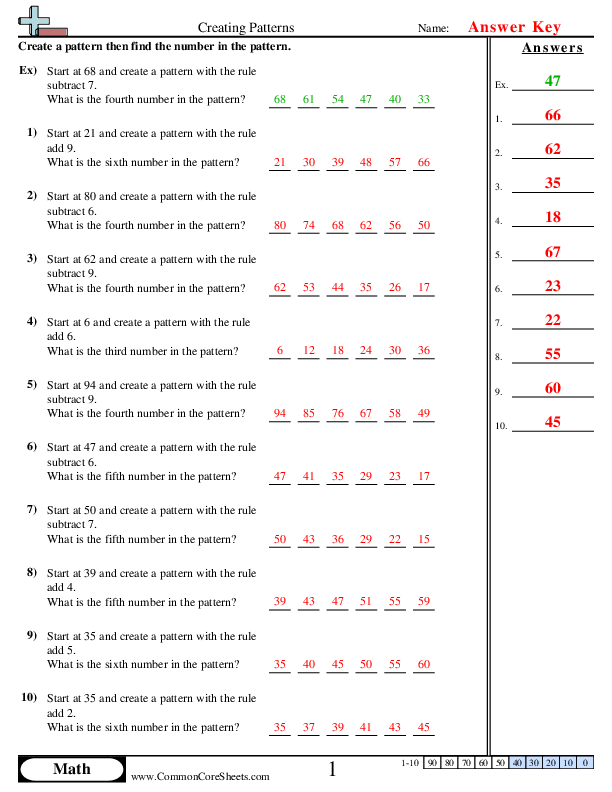
Creating Patterns
4oa5


×
Description:
"This worksheet is designed to enhance children's understanding of mathematical patterns. It involves 10 different problems, where students create sequences based on given rules and identify specific numbers in these patterns. From addition to subtraction, it offers various challenges to build their math skills. This flexible tool can be customized to fit various learning approaches, converted into flash cards, or integrated into distance learning programs for a versatile educational experience."

×
Student Goals:
Understanding PatternsUpon completion of this worksheet, students should be able to grasp the basic concept of numerical patterns. They will learn to recognize and predict patterns which are foundational skills in mathematics. These critical thinking skills can be utilized when tackling more advanced math concepts.Operational SkillsThe worksheet focuses on operations of both addition and subtraction. By persistently practicing and solving these problems, students will strengthen their operational skills. They will enhance their mental arithmetic abilities, understanding the procedure of adding and subtracting smaller or greater numbers.Problem-Solving SkillsThe worksheet deepens students' ability to solve problems independently. By figuring out the number patterns on their own, students will develop and improve their problem-solving skills. The problems encourage students to take an active approach towards learning, which also boosts their confidence in tackling similar problems in the future.Logical ReasoningStudents will significantly enhance their logical reasoning by recognizing the structure of patterns and the logic behind them. These exercises will allow learners to see the relationship between numbers, enabling them to make accurate and logical predictions about subsequent numbers in the sequence.Preparation for Advanced MathRecognizing and understanding pattern is a significant stepping stone towards learning advanced math concepts. The skills developed while working on this worksheet will assist students when they advance to more complex mathematical themes like algebra, where pattern recognition is crucial.Integration of KnowledgeFinally, after completing this worksheet, students will learn to integrate and apply their learned skills to other mathematical exercises and real-life situations. They will understand how patterns aren't just abstract concepts confined to the math class, but are present and applicable in everyday scenarios.


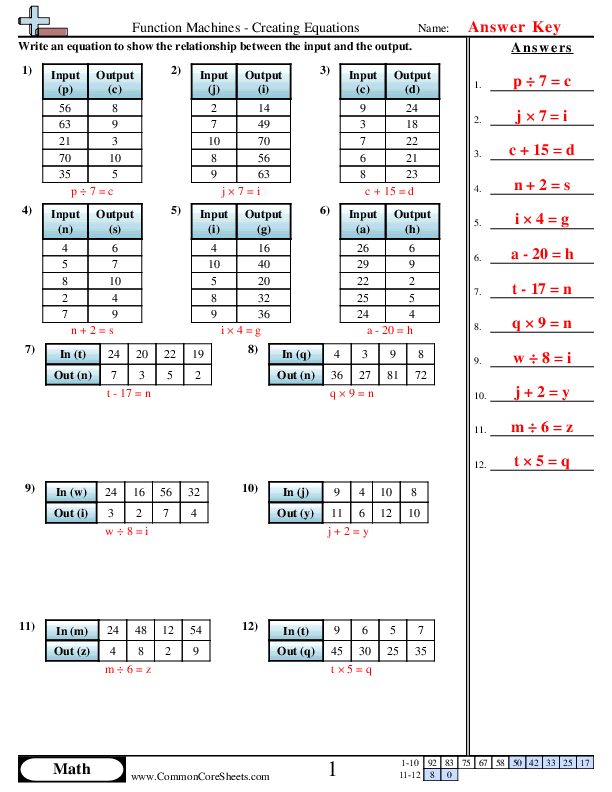
Function Machine - Creating Equations (+-×?)
5oa3


×
Description:
"This worksheet is designed to enhance children's understanding of mathematical functions, specifically the creation of equations. It includes 12 problems varying in addition, subtraction, multiplication, and division operations, all aiming to establish a correlation between 'input' and 'output'. Perfect for distance learning, this adaptable resource can be customized to suit individual learning needs or converted into flash cards for interactive practice."

×
Student Goals:
Understanding Function MachinesAfter completing the worksheet, students will have a clear understanding of how function machines work. They will be familiar with the principle of using an input to generate an output via a mathematical function. These skills are critical in leading students to comprehend more complex mathematics such as algebra.Creation and Interpretation of EquationsStudents will develop the ability to create and interpret different equations through real-world examples. This worksheet offers students an understanding of how to derive equations from given sets of input and output. They will further leverage this knowledge to solve more complex equations, fostering deep mathematical thinking.Application of Mathematical OperationsThis worksheet primarily focuses on the four fundamental operations in mathematics: addition, subtraction, division, and multiplication. By completing the tasks, the students will be able to apply these operations flexibly in different contexts to generate solutions.Reinforcing Problem-solving SkillsThe worksheet strengthens children's problem-solving skills. They learn to use logical thinking to decipher what mathematical operation has been used to transform the input into output through these function machines. This crucial skill will aid them in solving more challenging problems in the future.Sequential and Logical ReasoningUpon working their way through the worksheet, students will hone their ability to use sequential and logical reasoning in a mathematical context. They will understand the relationships between numbers and grasp the concept of cause-effect relationships in different mathematical operations.Confident Mathematics ApplicationFinally, but importantly, the successful completion of the worksheet will significantly boost students' confidence in their mathematical abilities. By being able to solve a plethora of problems, they will realize that they can apply mathematical concepts in real-world situations, inspiring them to explore more challenging aspects of mathematics.


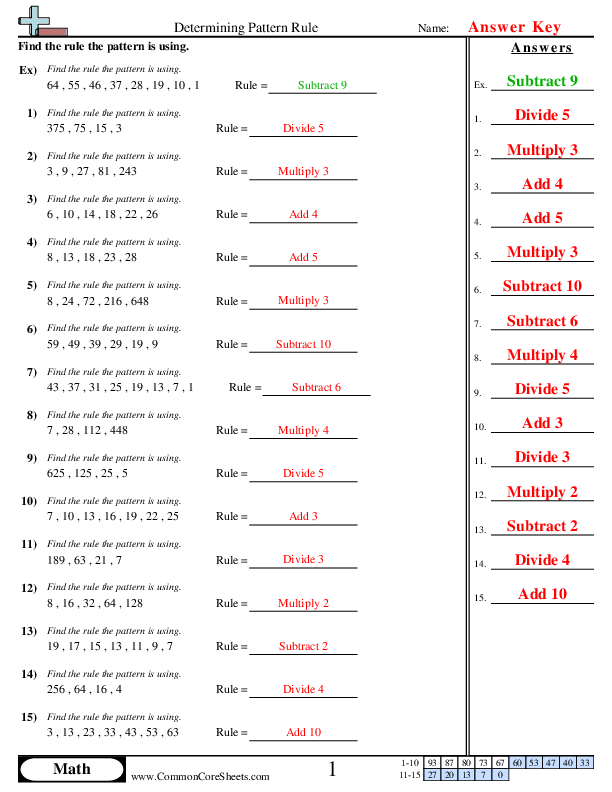
Pattern Rule


×
Description:
"This worksheet is designed to enhance children's understanding of mathematical patterns and the rules that govern them. Covering a range of operations, including addition, subtraction, multiplication, and division, the 15 problem set challenges problem-solving skills. Perfectly adaptable, this worksheet can be customized, transformed into flashcards, or utilized in distance learning settings, making it a versatile tool for reinforcing learning concepts in mathematics."

×
Student Goals:
Pattern RecognitionUpon completion of this worksheet, students should be capable of identifying and determining the rules of various types of numerical sequences. From simple addition or subtraction to more complex processes like multiplication or division, students will have enhanced their ability to identify continuity present in such patterns. Recognizing this will aid in prediction and extrapolation of future values in the sequence, which is a critical skill in mathematics.Problem SolvingStudents will also have strengthened their problem-solving abilities. Through this process, they learn to strategically approach, analyze, and solve a problem, which is a fundamental capability applicable not only in mathematics but also across many areas of life and study. Responding to these pattern problems fosters creativity in emergent mathematical thinking and promotes an analytical frame of mind.Critical ThinkingThe accomplishment of this task also strengthens students' critical thinking skills. The students will be required to analyze different numerical patterns and deduce a suitable rule that defines the patterns. This exercise ingrains in students the ability to make logical connections, an essential tool for critical thinking, consequently helping in the comprehension of complex math problems.Mathematical Vocabulary UnderstandingThis worksheet will help students to familiarize themselves with key mathematical terminology such as 'divide', 'multiply', 'add', and 'subtract'. These terms are essential to grasp numerical operations and will enable the students to apply these operations confidently in various contexts, which is crucial in their mathematical education journey.Pattern ApplicationAfter completing this worksheet, students should be able to apply the determined rule to extend the patterns. They would not only be able to grasp the concept of number patterns but also use this understanding to generate additional elements in a sequence. This ability to extend a pattern is useful in understanding progression in series, charting growth over time, and identifying numerous other mathematical phenomena.



Multiple Choice + , - , × , ÷


×
Description:
"This worksheet is designed to help children practice the concept of pattern rules in math. It features 12 differentiated problems that involve understanding numerical sequences and selecting the correct operation required. Whether by adding, subtracting, multiplying or dividing, students will tune their skills in recognizing patterns. The worksheet can be customized, turned into flash cards, or used in distance learning environments, making it highly versatile for various teaching methods."

×
Student Goals:
Understanding Math PatternsAfter completing the worksheet, students should be able to identify and understand the various mathematical patterns, involving addition, subtraction, multiplication, and division. They will be able to accurately determine the rule that governs a pattern, equipping them with the knowledge to predict the next terms in a series. This broadens their understanding of mathematical sequences and series and cultivates logical thinking.Problem Solving SkillsThe worksheet exercises are designed to enhance problem-solving skills of students. By means of honing their capability to detect the rule that creates a pattern, students train their analytical thinking. This proficiency is vital in mathematics, and is beneficial in a multitude of other areas such as sciences, computer technology, engineering, and more. The acquired skills transform the students into effective problem solvers.Critical ThinkingApplication of critical thinking is indispensable when discerning pattern rules. Through the substantial practice this worksheet provides, students will be able to analyze sequences and determine if they're created through addition, subtraction, multiplication, or division. They will learn to look beyond the obvious and excavate the reasoning behind patterns. This imperative skill broadens their perspective and equips them with a critical outlook.Mathematical ConfidenceMost importantly, these exercises build student confidence in handling numbers and mathematical operations. The ease with which they learn to tackle patterns and sequences owing to consistent practice leads to a sense of accomplishment. This fosters a positive attitude and cultivates interest towards more complex mathematical challenges, making them ready for advanced topics.Operational FluencyWith regular practice like these worksheets provide, students will be adept at executing basic mathematical operations like addition, subtraction, multiplication and division. This fluency is foundational to more complex mathematical learning and is important to the student's overall numerical literacy. Further, they will develop a good understanding of mathematical principles behind these operations, making them more conceptually clear.


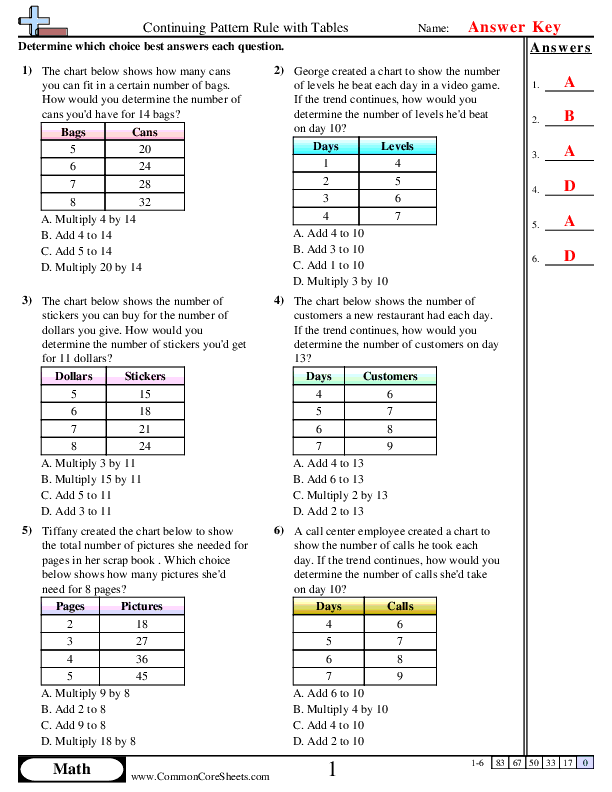
Continuing Pattern Rule with Tables


×
Description:
"This worksheet is designed to assist children in understanding continuous pattern rules using tables. It includes six example math problems that involve applying formulas based on patterns. Students learn critical thinking by determining cooking times, game points, drawing numbers, and more. Customizable for various learning needs, it can be converted into flash cards or utilized for distance learning, making it versatile and accessible."

×
Student Goals:
Understanding PatternsUpon completion of this math worksheet, students should have a much firmer grasp on identifying and understanding patterns. This important skill will allow them to predict future events or trends based on observed patterns. It strengthens cognitive abilities such as reasoning, generalizing, and problem-solving which are critical for more complex math concepts.Mastering TablesThe worksheet offers problems where inputs and outputs are illustrated in table form. Having worked through these problems, students will improve their ability to accurately and effectively interpret data from tables. This skill is a foundation for data analysis, a critical part of many disciplines, in and beyond mathematics.Applying Pattern RuleOne of the core learnings from this activity is the application of the pattern rule using tables. Students can predict or determine what comes next, after having identified the rule or pattern of the table. Math problems that focus on the pattern rule nurture a student's analytical mind and their ability to recognize and formulate rules.Multiplication and AdditionThe problems posed in the worksheet will provide the students with a practical application of addition and multiplication. By working out the pattern rules, students solidify their addition, and multiplication skills which are highly essential basic arithmetic concepts used in everyday life and advanced mathematics.Enhancing Logical ThinkingAfter completing this worksheet, students should be able to think logically. It encourages them to ask questions, make predictions, and establish connections, all part of logical thinking processes. Through these practical exercises, they're exercising and sharpening their logical thinking skills, enabling them to face more advanced problems in the future.Problem SolvingThe worksheet provides an opportunity for the students to enhance their problem-solving ability. As they formulate pattern rules based on the given data and use this rule to solve for unknowns, they're practicing how to break a problem down into smaller, more manageable parts, an essential aspect of effective problem-solving.


Continuing Number Patterns
Link
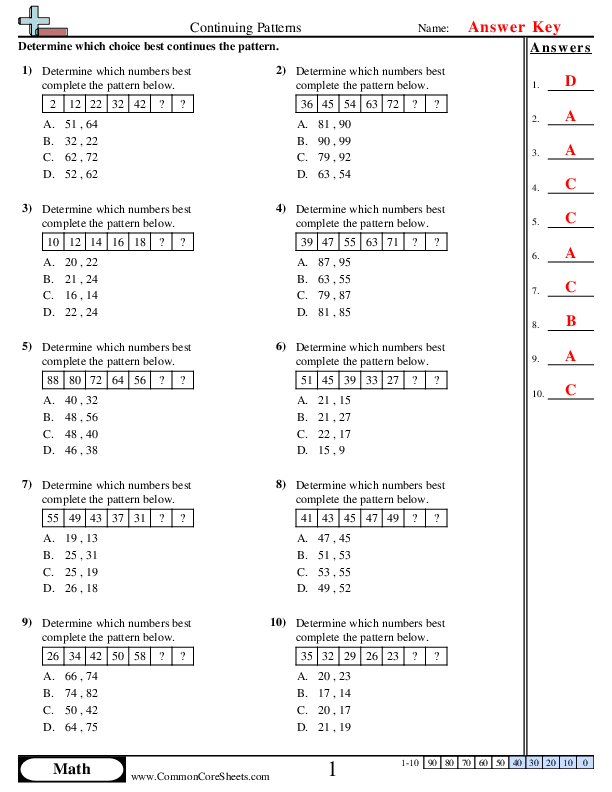
Continuing Patterns (+ - )
4oa5


×
Description:
"This worksheet is designed to enhance children's skills in recognizing and continuing mathematical patterns. It features ten problems that task students with identifying the next numbers in different numerical sequences. The content is manipulated effortlessly, providing the flexibility of customization for varying educational needs, such as distant learning resources and conversion into flashcards for interactive learning."

×
Student Goals:
Enhanced Mathematical UnderstandingAfter completing the worksheet on Continuing Patterns, students are expected to have an increased understanding of the fundamental concept of sequential patterns within mathematics. They should be able to identify a numerical series and predict the next numbers or steps in the given series effectively.Critical Thinking SkillsStudents should be able to demonstrate improved critical thinking skills, as the worksheet requires them to apply logic and reason to determine the provided pattern's continuation. Solving such number series puzzles cultivates analytical thinking ability, thus helping them to develop problem-solving strategies.Attention to DetailThe careful and diligent identification of numerical patterns by students in this worksheet should help to hone their attention to detail. They should be strengthened in their ability to decipher details, notice changes, and identify patterns within large groups of numbers.Numerical FluencyQuicker and more accurate number manipulation should be achieved through regular engagement with these problems. The worksheet will improve their numerical fluency, essential for tackling advanced mathematical problems, as it requires students to understand and operate number sequences.Pattern RecognitionBy investing time in this worksheet, students can improve their ability to recognize patterns, a vital skill in various STEM-related fields. The ability to understand and predict patterns can help students to make meaningful connections and understand the relationships in complex mathematical problems.Boosted ConfidenceSuccessfully solving pattern continuation problems can help build confidence in their own mathematical abilities. As the difficulties vary across the exercise, students should be able to thoroughly test their skills and get a sense of achievement, making them more eager to tackle complex math problems in the future.



Pattern Missing Number


×
Description:
"This worksheet is designed to enhance math skills by teaching pattern recognition and numerical sequences. It involves 15 problems requiring students to identify the next number in a series based on provided rules, such as addition, subtraction, multiplication, or division. Versatile and adaptable, the worksheet can be customized for an individual's learning pace, converted into interactive flash cards, or used for distance learning to ensure a comprehensive mathematical understanding."

×
Student Goals:
Problem-solving AbilityUpon completing the worksheet, the students will have improved their problem-solving abilities. They will demonstrate the capacity to decipher patterns in numbers which is a critical mathematical skill. With exercises that expose them to different sequence rules, students broaden their comprehension of the various ways in which sequences can be manipulated, understanding multiplication, division, addition, or subtraction operations within sequences.Mathematical SkillsThe students will have enhanced their mathematical skills. They'll gain precise knowledge of numerical relationships and how this applies to the sequences provided. Their numerical proficiency will be visible in how they’re able to predict subsequent numbers in a sequence, as they’ll understand how sequences are generally calculated and that providing the following number in a series requires comprehension of the pattern being used.Logical ReasoningThey will have sharpened their logical reasoning abilities. Discovering rules that guide a series and applying these rules to find an unknown number is a mental exercise that boosts their critical thinking skills. This is a concrete demonstration of the application of logic, which is beneficial not just for math, but for other fields of study as well.Attention to DetailStudents will develop keen attention to detail. In order to correctly determine the pattern rule and figure out the next number in the sequence, they must demonstrate careful observation. This attribute will allow them to spot trends and rules which are incredibly beneficial in mathematical problem solving.Accuracy and PrecisionThey will hone their accuracy and precision. The nature of mathematical operations is such that accuracy counts, and every decimal point matters. Completing this worksheet will train the students to strive for accuracy in all calculations to derive the correct sequence and predict the next numbers properly.Abstract ThinkingCompleting the worksheet will enhance the students' ability to think abstractly. While they deal with concrete numbers, the patterns they are required to discern are abstract concepts. Recognizing these patterns will move beyond simple arithmetic to incorporate more complex mathematical thinking.


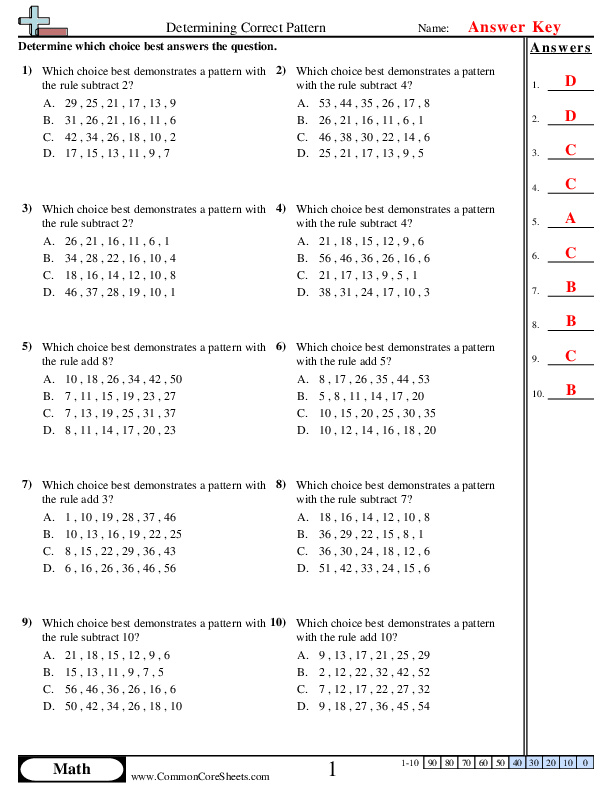
Determining Correct Pattern (+ , - )


×
Description:
"This worksheet is designed to aid children in understanding and identifying mathematical patterns. The focus lies in recognising patterns using rules of addition and subtraction. The worksheet, which features 10 problems of varied complexity, can easily be customized according to student needs. It can also be converted into engaging flashcards or effectively utilized in distance learning programs to promote a flexible, self-paced learning environment."

×
Student Goals:
Enhanced Mathematical SkillsUpon completing this worksheet, students will have an increased familiarity with mathematical patterns and rules. They will be able to distinguish and follow a numerical pattern based on a given rule, either by adding or subtracting numbers. They will gain proficiency in identifying patterns that comply with certain rules, so as to predict what appears next in the pattern.Developed Problem Solving AbilitiesChildren will improve their problem-solving abilities, as the tasks encourage finding solutions by identifying the correct pattern. This worksheet gives them a practical way to cultivate their analytical thinking abilities. These skills are essential in everyday life, especially in different professional fields, making this a worthwhile achievement.Improved Cognitive FunctionsAs these exercises compel students to think critically, they will notice better honing of their cognitive functions. It will result in stronger memory recall and improved concentration. Boosted cognitive function is a significant stepping stone toward successful learning in all academic areas, not just math.Increased Number UnderstandingStudents will better comprehend numerical relationships and the correlation between different numbers in a sequence. This comprehension lays the fundamentals for more complex fields in math, such as algebra and geometry. It provides a solid foundation of basic arithmetic upon which more advanced concepts can be built.Gained Confidence in MathematicsLastly, successfully solving these problems can help boost students' confidence in their mathematical capabilities. This increased self-assurance can lead to improved academic performance and a more positive attitude toward math and similar subjects. Regardless of their future path, feeling confident in their abilities will be immensely beneficial.


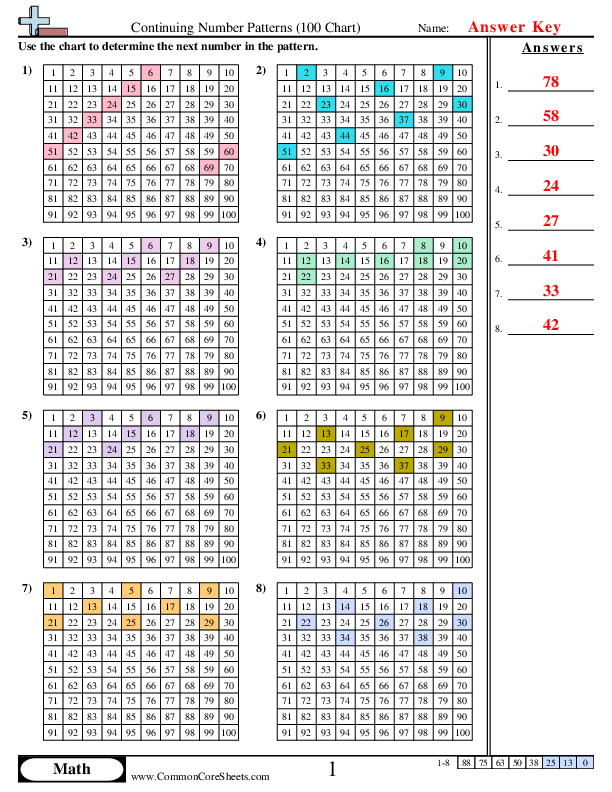
100 Chart Patterns


×
Description:
This worksheet is designed to enhance children's understanding of continuing number patterns up to 100. It provides eight engaging problems to challenge and develop skills in recognizing and predicting sequential patterns in mathematics. The versatile format allows the worksheet to be customized for individual needs, easily converted into flash cards, or used in distance learning settings, offering a valuable tool in both classroom and home education.

×
Student Goals:
Enhanced Number RecognitionAfter completing the worksheet, students should have enhanced skills in recognizing numbers. They should be comfortable with identifying numbers from 1 to 100. Understanding both the sequence and patterns of numbers is a key principle of mathematics, and this worksheet should have served to reinforce these foundational concepts.Developed Numerical Patterns UnderstandingThe students should have developed an understanding of numerical patterns. Number sequences are an integral part of mathematics and this worksheet would have provided the learners with an opportunity to recognize and understand number sequences and patterns. Students are expected to fill in the gaps in the number sequences successfully, signaling a strong understanding of patterns.Increased Cognitive AbilitiesUpon completion of this worksheet, the children's cognitive abilities in recognizing, continuing, and predicting number patterns should have significantly increased. They should be able to identify the rule a given pattern follows and predict the further sequence. This exercise will enhance their logical thinking, a critical skill that resonates not only in math but in problem-solving tasks across various subjects.Improved Pattern Recognition SkillsIn-depth pattern recognition is a skill the children should have improved upon greatly after completing this worksheet. Recognizing patterns is useful when learning about the order and methods of counting and contributes significantly to building solid math foundations.Increased Confidence in Math CompetencyAt the end of this activity, students should feel a boost in their confidence in their mathematical competencies. The recognition and understanding of patterns help in comprehending the logical connections and structures of numbers, which is essential in tackling complex mathematical problems. Hence, successfully completing the worksheet should increase their confidence and appetite for more math problems.Developed Focus and Concentration SkillsThrough working on this worksheet, students should have developed improved focus and concentration skills. Having to fill in the missing numbers on a 100 chart requires a high level of attention to detail, which not only improves the focus but also increases patience in learning new things and accomplishing tasks with precision.


Continuing Visual Patterns
Link
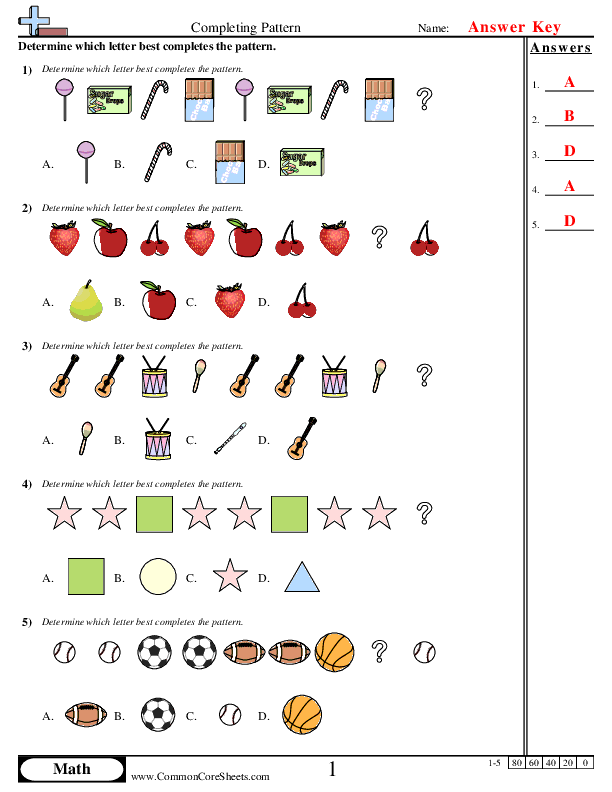
Continuing Patterns (Visual)


×
Description:
"This worksheet is designed to enhance children's mathematical skills, specifically in completing patterns. It features 5 engaging problems that challenge kids to identify the correct letter to complete a sequence. Versatility is key, as the materials can be customized according to learner's levels, transformed into interactive flash cards for a change of method, or utilized effectively in a distance learning setup."

×
Student Goals:
Understanding and Identifying PatternsAfter completing this worksheet, students will develop a clear understanding of simple and complex pattern structures. They will be able to recognize and interpret different types of patterns effectively. Their cognitive skills of observation and discerning similarities and differences will be enhanced.Letter RecognitionStudents will also sharpen their letter recognition skills. They will be able to quickly and accurately identify distinct letters and understand their place within a pattern, thereby improving their proficiency in alphabet recognition.Critical Thinking and Problem-SolvingUpon the completion of the worksheet, students' critical thinking abilities will have been further developed. They will cultivate the capacity to think logically and systematically, as they decide which letter best completes the given patterns. As a result, their problem-solving skills will be strengthened.Enhancement of ConcentrationEngaging with pattern problems, students will improve their focus and attention to detail. As this worksheet requires thoughtful consideration of each problem, students will have practiced maintaining their concentration over extended periods of time, demonstrating persistence and determination as they work towards finding the right solution.Preparation for Advanced Mathematical ConceptsThe process of identifying patterns is a foundational skill in math. By mastering these exercises, students will be well-prepared to grasp more advanced mathematical concepts in future lessons, such as sequences and series, as the concepts inherent to this worksheet form a base for these more advanced topics.


Identifying Functions
Link
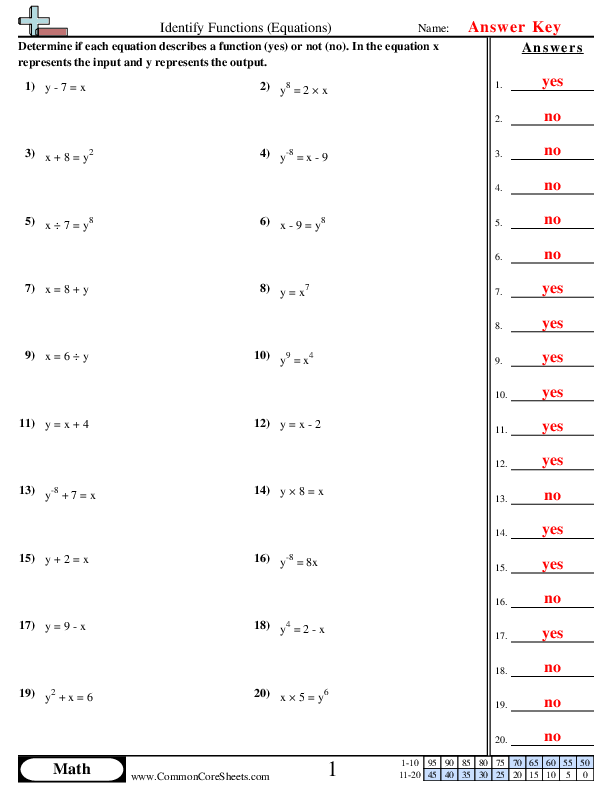
Identify Functions (Equations)
8f1


×
Description:
"This worksheet is designed to enhance children's understanding of mathematical functions, specifically equations. It contains 20 math problems asking to identify functions presented in different formats. Ideal for distance learning, the worksheet's content can also be customized or converted into flash cards to facilitate enjoyable practice. The varying complexity of the problems ensures solid mastery of the topic."

×
Student Goals:
Problem Solving SkillsUpon completion of the worksheet, students will have significantly improved their problem solving abilities. They will be able to accurately identify and analyze mathematical functions, strengthening their ability to understand and categorize different equations. This ability fosters a precision-based approach to math, promoting intellectual flexibility and adaptive reasoning.Mathematical LiteracyStudents will improve their overall mathematical literacy, more specifically in understanding functions. Decoding equations, grasively other mathematical concepts. This broadened understanding can stimulate logical thinking, supporting effective decision-making, and problem-solving across various facets of life.Critical ThinkingProper comprehension of mathematical equations requires critical thinking - a skill that children can significantly enhance by accomplishing this worksheet. It will enable them to strategically approach problems by recognizing patterns, understanding relationships between variables, and deducing the behavior of mathematical functions.Conceptual UnderstandingThis worksheet helps to strengthen students' conceptual understanding of equations and basic math operations. They will get familiarized with variable expressions, constants, and their interrelationships, providing an excellent foundation for more intricate concepts in higher-level mathematics.Application SkillsCompleting the worksheet will enable students to apply their knowledge to real-world scenarios. As they get acquainted with different mathematical functions, they can better quantify and model various real-world phenomena and problems, thereby translating abstract concepts into practical applications.Accelerated LearningThe worksheet is designed to enhance students' mathematical proficiency in a stress-free environment, which can accelerate their learning. By solving the problems, the students will be enabling cognitive connections to multiple math concepts. This can trigger lasting understanding and ease math anxiety, creating a positive mindset towards learning.Preparation for Advanced TopicsBy mastering the functions and equations in this worksheet, students will be well-prepared to tackle more advanced topics. This understanding forms a strong foundation for algebra, calculus and other advanced study areas. It also serves as a springboard into more complex mathematical theories, thereby fostering interest in such topics and enhancing college and career readiness.



Identify Functions (Graphs)
8f1


×
Description:
"This worksheet is designed to help children identify functions in mathematical graphs. It features six problems which challenge young minds to interpret equation-based graphs such as y-1 = -x, -y = x1, and others. Besides, it can be customized to meet specific learning needs, be easily converted into flash cards for interactive learning, or be used in a distance learning context to reinforce mathematical concepts."

×
Student Goals:
Understanding of Graphical FunctionsUpon completion of the worksheet, students should develop a deeper understanding and ability to interpret and identify functions represented graphically. This ability is pivotal in mathematics, which forms an integral part of problem-solving in various disciplines from physical to social sciences.Problem Solving and Analytical SkillsThe worksheet will help students to enhance their analytical skills in mathematics. Every problem in the worksheet requires students to apply their knowledge to solve the problems independently, thereby strengthening their logical thinking and problem-solving abilities.Master Different Forms of FunctionsStudents will learn to work with different forms of functions through this worksheet. They will become proficient in recognizing various types of functions like polynomial, linear, cubic, quadratic, and inverse relations, thus widening their understanding of the diverse nature of mathematical functions.Interpretation of Algebraic EquationsStudents will practice interpreting and transcribing algebraic equations, a skill essential to many areas of mathematics. The visual understanding of equations fosters mathematical fluency and contributes to the overall comprehension of algebra.Translating GraphsStudents will learn how to accurately translate numerical information into graphical form, enhancing their skill of visual representation of mathematical data. The ability to graph equations allows students to visualize relationships between different sets of numbers.Confidence in Mathematical ProficiencyThe successful completion of this worksheet aids in fostering confidence in mathematical proficiency. This will encourage students to take on more challenging tasks, participating actively in classroom activities, and develop an inclination towards the subject leading to future academic success in the field.



Identifying Functions (Tables)
8f1


×
Description:
"This worksheet is designed to instruct children in mathematical functions using tables. It employs 15 distinct puzzles, where X and Y values interrelate, teaching essential numbering concepts. Offering customizability, it can be seamlessly adapted into flash cards or integrated into a distance learning curriculum, enhancing the learning experience and reinforcing critical math skills."

×
Student Goals:
Mathematical understandingAfter completing this worksheet, students should have developed a deeper understanding of functions and how they correspond to tables. They should be able to proficiently read, understand, and interpret data from tables. Moreover, they should be familiarized with the concept of XY table and how changes in one variable (X) can affect another variable (Y).Problem-solving skillsThis exercise will equip students with essential problem-solving skills as they would have encountered and worked through a variety of unique problems. Working with 15 different mathematical problems helps to cultivate flexibility and tenacity in problem-solving, as they are required to identify patterns and apply logic to solve problems.Analytical skillsStudents should acquire analytical skills that are quintessential in mathematics and science subjects. They should be more adept at identifying patterns, discerning relationships between variables (XY pairs), and predicting outcomes based on certain trends. This worksheet will have shaped better analytical thinkers who can analyze, evaluate, and synthesize information effectively.Critical ThinkingBy solving these function problems, students will boost their critical thinking skills. They should be more competent at identifying relationships, making assumptions, and reaching conclusions based on information presented in tables. Such skills are invaluable for more advanced mathematical concepts.Mastery of Mathematical ConceptsAfter completing the worksheet, the students should master how to identify different types of functions from a table. They will understand the correlation between two numbers in an XY pair and how changes in X affect Y. This mastery of basic mathematical concepts will serve as a strong foundation for understanding more complex math theories in future.


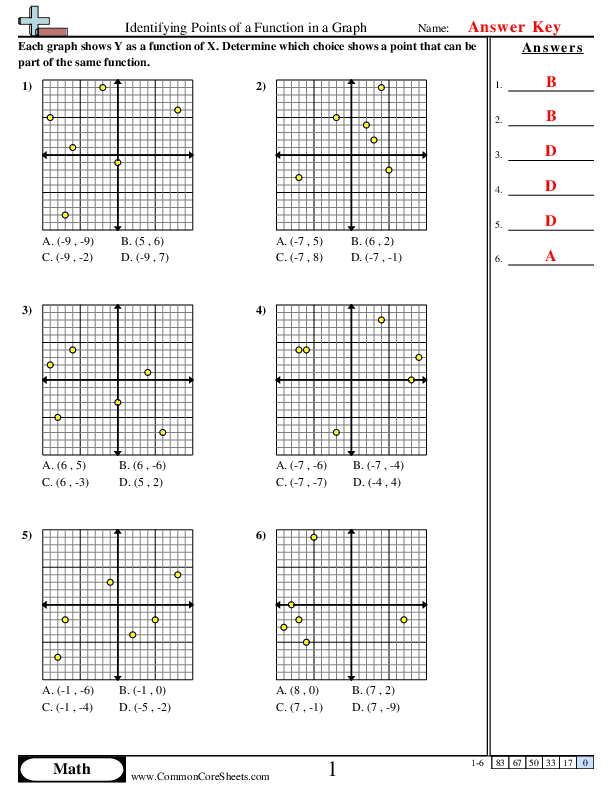
Identifying Points of a Function in a Graph
8f1


×
Description:
"This worksheet is designed to help children understand the concept of identifying points of a function in a graph within the subject of math. Featuring six problems with varying coordinates, it promotes problem-solving and analytical thinking. The worksheet can be customized to suit individual learning styles, easily converted into flashcards, and is ideal for distance learning situations."

×
Student Goals:
Skill DevelopmentAfter completing the worksheet, students will have honed their skills in identifying points of a function in a graph. They will have a better understanding of the Cartesian coordinate system, be able to interpret coordinates, and understand their relationship with graphs. In the process, they improve their mathematical reasoning and analytical thinking skills.Application of KnowledgeThe students will further be able to apply this knowledge in solving more complex mathematical problems. They will be equipped to analyze graphs more accurately, identify patterns, and understand how changes in numbers can affect the position of points in the plot. This knowledge is not only applicable in studying functions but also extends to areas like physics and engineering.Critical ThinkingThe worksheet tasks will stimulate the students' critical thinking abilities. By identifying points of a function, students learn to solve problems logically and systematically. It fosters their ability to think critically by interpreting and analyzing graphical data.Preparation for Future ConceptsMoreover, the acquired skills will prepare students for more advanced mathematical concepts such as interpreting complex functions, solving for unknown variables, implementing mathematical models and integrating different mathematical methods.Boosting ConfidenceSuccessfully understanding and completing this worksheet can significantly boost students' confidence, fostering a positive and proactive attitude towards learning math. It validates their ability to understand complex concepts and can ignite a passion for learning more about the subject.Building a Solid FoundationHandling such exercises enhances the arithmetic and algebra skills of the students, thus cementing their foundation in math. They will have a greater capacity to visualize mathematical problems, building a robust platform for further learning in advance mathematics, and other disciplines that require knowledge of mathematical relationships.


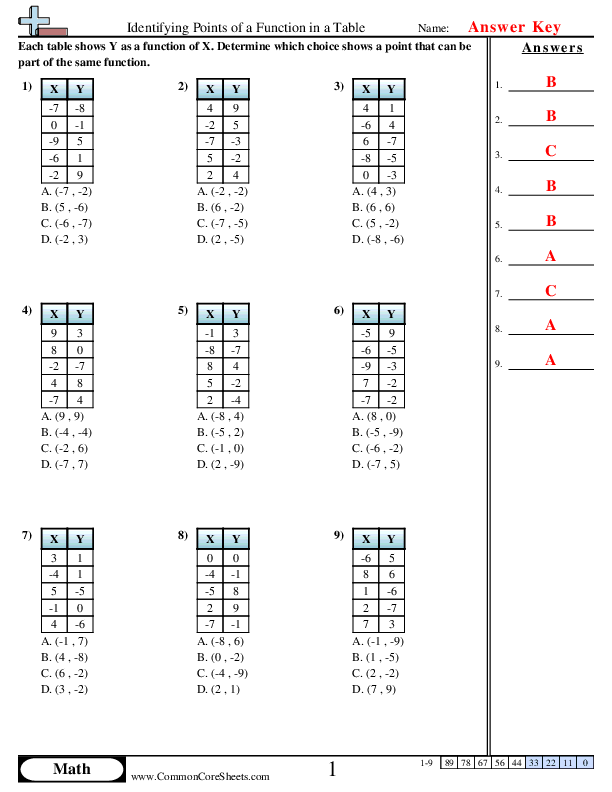
Identifying Points of a Function in a Table
8f1


×
Description:
"This worksheet is designed to reinforce children's understanding of identifying points on a function within a table. Through engaging math problems, learners will explore key concepts related to the coordinate plane. Featuring nine customisable problems that can be converted into flashcards or utilized in distance learning, it offers a dynamic and adaptive resource to aid their mathematical development."

×
Student Goals:
Function IdentificationAfter successfully completing this worksheet, students will have thoroughly familiarized themselves with identifying points of a function in a table. This fundamental mathematical operation plays a vital role in the world of mathematics, and understanding it opens the door to a wide scope of related topics. The operation itself requires an understanding of function as a cornerstone of mathematics, experimental skills in matching pairs and keen attention to detail.Critical Thinking EnhancementThe worksheet tasks are carefully curated to ensure students develop critical thinking skills. Any mathematical operation requires strategic reasoning and thoughtful problem-solving. The ability to make accurate deductions and decisions is a critical character trait that students will improve on upon completion of the worksheet. They will be able to execute better reasoning skills to solve real-life problems even outside the classroom.Enhancement of Computational SkillsIn addition to understanding the key concept of function identification, this worksheet also aids in honing the students' computational skills. Computing and coordinating XY values is a skill that needs practice, and this worksheet provides the perfect opportunity to perform and perfect these computations. It allows an excellent platform for students to learn and practice solving problems using a systematic approach that can be applied universally.Understanding Mathematical LanguageThrough this worksheet, students will gain a comprehensive understanding of the language of mathematics and the ability to translate it into understandable terms. The exercise in distinguishing relationships between variables contributes to a broader understanding of the patterns and principles constituting the mathematical universe.Increased ConfidenceFinally, throughout this worksheet, students will build confidence in their math skills. As they work through each problem and learn to identify the correct points on the function table, they will also be reinforcing their math base. This assurance can generate a positive attitude towards math and other similar tasks, resulting in an overall academic improvement. Confidence in their ability to surmount challenges gives them the momentum to tackle more complex equations with enthusiasm and tenacity.


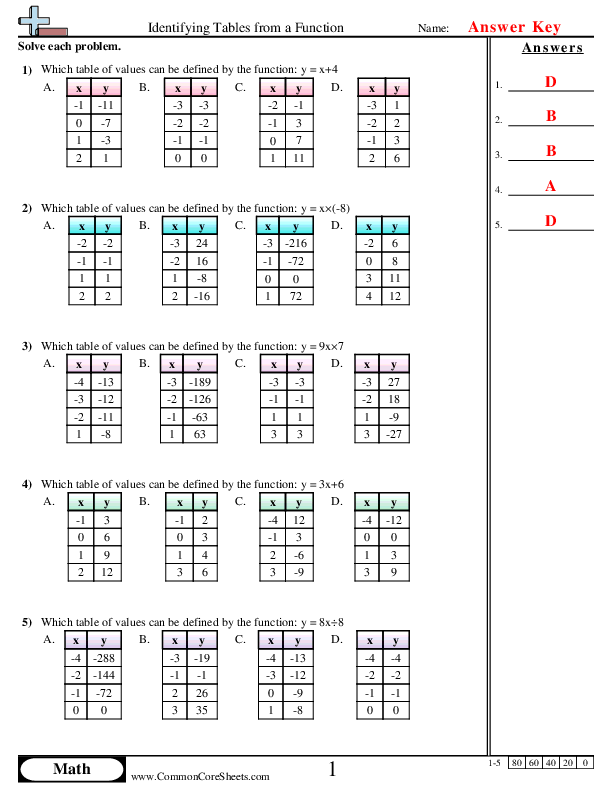
Identifying Tables from a Function
8f1


×
Description:
"This worksheet is designed to enhance children's understanding of mathematical functions. Its interactive examples will prompt learners to identify value tables defined by simple equations, sharpening skills in problem-solving and basic algebra. With five different problems to solve, the content provides an engaging way of reinforcing knowledge. The worksheet's versatile nature allows customization, conversion into flashcards for quick learning, or integration into distance learning programs, making math practice more effective and flexible."

×
Student Goals:
Strengthened Understanding of Basic Mathematical FunctionsWith the completion of this worksheet, students will have a more profound comprehension of primary mathematical functions. They will be well-versed with visually identifying and interpreting tables from a function which is a foundational skill in algebraic mathematics. The worksheet supports the reinforcement of knowledge about different types of functions and how the variables interact in each function.Sharpened Problem-Solving SkillsThe worksheet is designed to test students understanding thus improving their mathematical problem-solving skills. They will be able to solve complex problems that involve deriving a table of values from given functions. This critical skill not only is applicable in advanced mathematical engagements but also in real-world situations that involve data interpretation.Augmented Analytical AbilitiesBy successfully identifying tables from a function, students will enhance their analytical abilities. This worksheet allows learners to analyze various functions and match them with the correct tables of values. Hence, this pushes students to think analytically and logically, which extends beyond mathematics to daily life situations.Improved Conceptual KnowledgeWith the help of this worksheet, students will gain improved conceptual knowledge about mathematical functions. Understanding the abstraction of functions and how they map to concrete values is an invaluable skill in advanced mathematics. Students will be able to visualize different scenarios where given functions can apply, further deepening their conceptual understanding of math topics.Boost Confidence in MathematicsSuccessfully completing this worksheet will boost students confidence in their mathematical abilities. As the students identify tables from a function, they will become more confident in using functions to identify values and vice versa. This increased self-confidence can lead to better results in future mathematical tasks and contributes to a positive perception of one's mathematical abilities.













